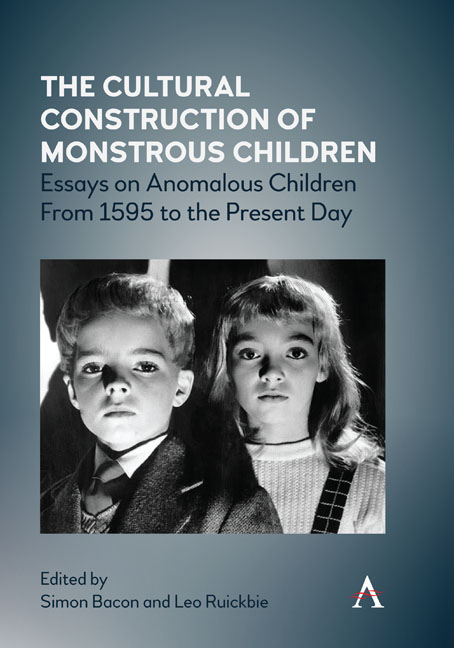 The Cultural Construction of Monstrous Children
The Cultural Construction of Monstrous Children Book contents
- Frontmatter
- Contents
- List of Illustrations
- Acknowledgements
- Introduction
- Part I Historical Case Studies
- Part II Factual Anxiety in Fictional Representations: The Undead Child
- Part III Factual Anxiety in Fictional Representations: The Monstrous Child
- Part IV Cultural Categorization in the Past, Present and Possible Future
- Notes on Contributors
- Index
Chapter Ten - From the Monster to the Evil Sinthomosexual Child: Category Mixing, Temporality and Projection in Horror Movies
Published online by Cambridge University Press: 20 January 2022
- Frontmatter
- Contents
- List of Illustrations
- Acknowledgements
- Introduction
- Part I Historical Case Studies
- Part II Factual Anxiety in Fictional Representations: The Undead Child
- Part III Factual Anxiety in Fictional Representations: The Monstrous Child
- Part IV Cultural Categorization in the Past, Present and Possible Future
- Notes on Contributors
- Index
Summary
Introduction
From the start of the twenty-first century two figures have undergone increased scrutiny and analysis in cultural studies: the monster and the evil child. Appearing in different media, from literature to cinema and including comic books, these two figures have raised new interests as major cultural representations to understand our culture and especially its production of margins and its logics of exclusion. The relationship between these two figures nevertheless remains underexplored. In this chapter, adopting a genealogical reading of the blood tie between these two figures and relying on Lee Edelman's notion of sinthomosexuality and reprofuturism, I will argue that the monster and the evil child share the same function of blurring the cognitive categories on which our perception of reality relies. However, since the monster and the evil child live in different temporalities, they have different psychological and cultural functions.
In his widely acclaimed polemical essay No Future, Lee Edelman convincingly argues that the figure of the child fulfils a rhetorical function as it is wielded in both conservative and liberal discourses. By constantly justifying political stance in the name of the present and future child, these discourses seem to imply that any political opposition would therefore be against the child. The unquestionable one-sided rhetorical use of this figure, this ‘fascism of the baby's face’, far from being linked to a real child made of flesh and blood, is a historical formation that Edelman situates at the core of reprofuturism. The future, by slowly becoming the centre of modern political discourse, has become less a temporal dimension than a value and has found its figurative embodiment in the child. However, while projecting its fantasy of a brighter world that must reveal itself in a time to come, ideological discourse also agitates the spectre of a darker future that will surely come if we don't ward it off with the sacred power of the ballot. Therefore, the future has to be protected, as does the child who, in the reprofuturism's metanarrative, is the tiny and tenuous link sustaining and securing the transmission of our values into a brighter horizon.
- Type
- Chapter
- Information
- The Cultural Construction of Monstrous ChildrenEssays on Anomalous Children from 1595 to the Present Day, pp. 165 - 176Publisher: Anthem PressPrint publication year: 2020


